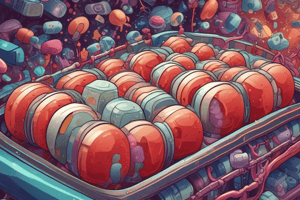Podcast
Questions and Answers
What is the primary mechanism by which daptomycin affects bacteria?
What is the primary mechanism by which daptomycin affects bacteria?
- Blocking RNA synthesis
- Interfering with ribosomal function
- Inhibiting DNA synthesis
- Disrupting membrane potential (correct)
Which of the following antibiotics is classified as a fluoroquinolone?
Which of the following antibiotics is classified as a fluoroquinolone?
- Rifamycin
- Ciprofloxacin (correct)
- Vancomycin
- Daptomycin
What type of infections is rifamycin particularly effective against?
What type of infections is rifamycin particularly effective against?
- Fungal infections
- Gram-negative bacterial infections
- Mycobacterial infections (correct)
- Viral infections
Which of the following statements about the action of antibiotics is true?
Which of the following statements about the action of antibiotics is true?
Which of the following is a common side effect of rifamycin?
Which of the following is a common side effect of rifamycin?
Which antibiotic would be effective against methicillin-resistant Staphylococcus aureus (MRSA)?
Which antibiotic would be effective against methicillin-resistant Staphylococcus aureus (MRSA)?
Fluoroquinolones primarily affect which aspect of bacterial function?
Fluoroquinolones primarily affect which aspect of bacterial function?
What is the primary use of rifamycin?
What is the primary use of rifamycin?
Which of the following antibiotics affects the synthesis of bacterial RNA?
Which of the following antibiotics affects the synthesis of bacterial RNA?
A patient with vancomycin-resistant Enterococci is most likely to be treated with which antibiotic?
A patient with vancomycin-resistant Enterococci is most likely to be treated with which antibiotic?
What is the primary bacterium responsible for the natural synthesis of rifamycins?
What is the primary bacterium responsible for the natural synthesis of rifamycins?
Which of the following is NOT a rifamycin derivative?
Which of the following is NOT a rifamycin derivative?
Which metabolic pathway is primarily targeted by sulfonamides?
Which metabolic pathway is primarily targeted by sulfonamides?
What is a common side effect of topical antifungal agents?
What is a common side effect of topical antifungal agents?
Which route of administration is NOT commonly used for antivirals?
Which route of administration is NOT commonly used for antivirals?
Which of the following drugs specifically targets the synthesis of mycolic acid?
Which of the following drugs specifically targets the synthesis of mycolic acid?
What is one of the routes for administering antivirals besides oral?
What is one of the routes for administering antivirals besides oral?
Which symptom is most likely associated with the use of topical antifungal agents?
Which symptom is most likely associated with the use of topical antifungal agents?
Which method of administration is least likely used for delivering antiviral medications?
Which method of administration is least likely used for delivering antiviral medications?
What can be a side effect of using topical antifungal agents?
What can be a side effect of using topical antifungal agents?
What is the primary distinction between antibiotics and antimicrobials?
What is the primary distinction between antibiotics and antimicrobials?
Which mechanism of action do β-lactam antibiotics primarily employ?
Which mechanism of action do β-lactam antibiotics primarily employ?
What is the role of bacitracin in bacterial treatment?
What is the role of bacitracin in bacterial treatment?
What effect do polymyxins have on Gram-negative bacteria?
What effect do polymyxins have on Gram-negative bacteria?
Which of the following antibiotics is classified as a β-lactam antibiotic?
Which of the following antibiotics is classified as a β-lactam antibiotic?
What type of synthesis is disrupted by lipopeptides such as daptomycin?
What type of synthesis is disrupted by lipopeptides such as daptomycin?
What is the common characteristic of all antibiotics listed under β-lactam antibiotics?
What is the common characteristic of all antibiotics listed under β-lactam antibiotics?
Which statement about antimicrobials is incorrect?
Which statement about antimicrobials is incorrect?
Which component of bacterial cells is directly affected by antibiotics that interfere with nucleic acid synthesis?
Which component of bacterial cells is directly affected by antibiotics that interfere with nucleic acid synthesis?
What defines a bactericidal antibiotic?
What defines a bactericidal antibiotic?
Flashcards
Antimicrobial Drugs
Antimicrobial Drugs
A broad category of medications that target microorganisms like bacteria, fungi, viruses, and parasites to prevent or reduce infection.
Antibiotics
Antibiotics
A type of antimicrobial drug specifically designed to kill or inhibit the growth of bacteria.
Bactericidal Antibiotics
Bactericidal Antibiotics
Antibiotics that directly kill bacteria.
Bacteriostatic Antibiotics
Bacteriostatic Antibiotics
Signup and view all the flashcards
How Antibiotics Work
How Antibiotics Work
Signup and view all the flashcards
β-Lactam Antibiotics
β-Lactam Antibiotics
Signup and view all the flashcards
Peptidoglycan
Peptidoglycan
Signup and view all the flashcards
Bacitracin
Bacitracin
Signup and view all the flashcards
Polymyxins
Polymyxins
Signup and view all the flashcards
Lipopeptides (e.g., Daptomycin)
Lipopeptides (e.g., Daptomycin)
Signup and view all the flashcards
Daptomycin's Action
Daptomycin's Action
Signup and view all the flashcards
Daptomycin Targets
Daptomycin Targets
Signup and view all the flashcards
Antibiotics and Ribosomes
Antibiotics and Ribosomes
Signup and view all the flashcards
Fluoroquinolones Action
Fluoroquinolones Action
Signup and view all the flashcards
Rifamycin Action
Rifamycin Action
Signup and view all the flashcards
Rifamycin's Effectiveness
Rifamycin's Effectiveness
Signup and view all the flashcards
Rifamycin's Uses
Rifamycin's Uses
Signup and view all the flashcards
Rifamycin Side Effects
Rifamycin Side Effects
Signup and view all the flashcards
Rifamycin Antibiotics
Rifamycin Antibiotics
Signup and view all the flashcards
How Do Sulfonamides Work?
How Do Sulfonamides Work?
Signup and view all the flashcards
What Does Isoniazid Do?
What Does Isoniazid Do?
Signup and view all the flashcards
Topical Antifungal Side Effects
Topical Antifungal Side Effects
Signup and view all the flashcards
Routes of Antiviral Administration
Routes of Antiviral Administration
Signup and view all the flashcards
Viral Skin Infection Treatment
Viral Skin Infection Treatment
Signup and view all the flashcards
Trimethoprim
Trimethoprim
Signup and view all the flashcards
Sulfones
Sulfones
Signup and view all the flashcards
What are Rifamycin Derivatives?
What are Rifamycin Derivatives?
Signup and view all the flashcards
Common Antiviral Administration Routes
Common Antiviral Administration Routes
Signup and view all the flashcards
Study Notes
Antimicrobial Pharmacology
- Antimicrobials are agents aiming to reduce infection and sepsis.
- Antibiotics are derived from molds or synthetically created.
- Antibiotics aim to kill bacteria (bactericidal) or prevent their multiplication (bacteriostatic).
Basis of Antibiotics Action
- Various antibiotics impair bacterial functions by:
- Interfering with cell wall synthesis.
- Disrupting plasma membrane integrity.
- Inhibiting nucleic acid synthesis.
- Affecting ribosomal function.
- Altering metabolic pathways, including folate synthesis.
β-Lactam Antibiotics
- Examples include penicillin, cephalosporin, and carbapenem.
- These antibiotics contain a β-lactam ring.
- They work by inhibiting the final step in bacterial cell wall peptidoglycan synthesis.
Mode of Action for Bacitracin
- Bacitracin is a polypeptide produced by Bacillus subtilis.
- It's a gram-positive, catalase-positive bacterium, commonly found in the environment, not pathogenic to humans.
- Bacitracin inhibits peptidoglycan synthesis in a step of bacterial cell wall synthesis.
- Peptidoglycan forms an envelope around the cytoplasmic membrane of most bacterial species.
Antibiotics and Plasma Membrane Function
- Polymyxins (like polymyxin B and colistin) disrupt the outer cell membrane.
- They bind and neutralize lipopolysaccharide, inhibiting respiration in gram-negative bacteria.
- Lipopeptides, such as daptomycin, bind to bacterial membranes, leading to depolarization of the membrane potential.
- Disruption of the membrane potential inhibits DNA, RNA, and protein synthesis.
- Daptomycin effectively treats gram-positive bacterial infections, including MRSA and VRE.
Antibiotics and Ribosomes
- Important classes of protein synthesis inhibitors include chloramphenicol, macrolides, and lincosamides, that bind to the 50S ribosomal subunit.
- They prevent peptide bond formation and stop protein synthesis.
- Aminoglycosides bind to the 30S ribosomal subunit and disrupt proofreading, causing faulty protein production.
- Tetracyclines also bind to the 30S ribosomal subunit, hindering tRNA binding and thus inhibiting protein synthesis.
Antibiotics and DNA/RNA synthesis
- Fluoroquinolones (e.g., ciprofloxacin, levofloxacin, moxifloxacin) inhibit DNA synthesis.
- Rifamycin inhibits RNA synthesis.
Rifamycin
- Rifamycin acts by affecting RNA synthesis in bacteria.
- It's particularly effective against mycobacteria, treating tuberculosis, leprosy, and Mycobacterium avium complex (MAC) infections.
- Common side effects include constipation and headache.
- Synthesized either artificially or naturally by the bacterium Amycolatopsis rifamycinica.
- Includes rifampicin, rifaximin, rifabutin, rifapentine, and rifalazil.
Antibiotics and Metabolic Pathways
- Sulfonamides, sulfones, and trimethoprim interfere with folic acid synthesis.
- Isoniazid affects mycolic acid synthesis.
Side Effects of Topical Antifungal Agents
- Common side effects include burning, stinging, swelling, irritation, and redness.
Routes of Administration for Antivirals
- Most antivirals are oral drugs.
- Other routes include topical creams, eye drops, small-particle aerosols, and intravenous administration.
Drugs for Common Viral Skin Infections
- Antivirals like acyclovir, penciclovir, famciclovir, and valacyclovir are used against herpes simplex virus (HSV-1).
- Topical salicylic acid and cantharidin are used against human papillomavirus (HPV) infections (warts).
Studying That Suits You
Use AI to generate personalized quizzes and flashcards to suit your learning preferences.




